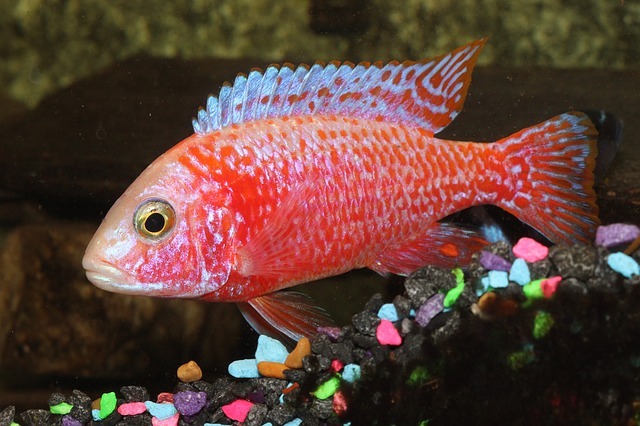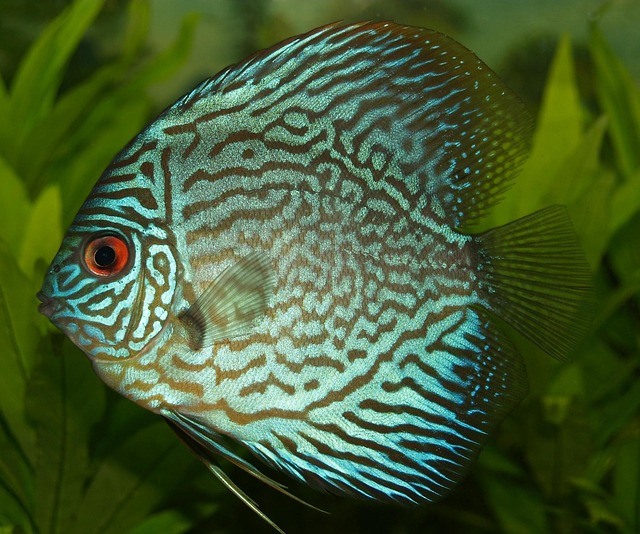Most potential fish owners are drawn to cichlids due to the species’ intelligence. These crafty creatures are nearly dog-like in the way they behave; they are territorial, aggressive, but also paternal towards their young.
When you’re looking for a fish more engaging than average, a cichlid will not only challenge you as a fish owner, but a school of them will entertain you with their unusual behaviors.
The care and keeping of a cichlid school do demand more attention than your average fish, but so long as you keep their needs in mind, you’ll be able to set up the perfect cichlid tank without any issues at all.
Contents
Cichlid Stats
- Size: 4 inches to 12 inches (general).
- Ideal Tank pH: 7.8 to 8.5.
- Ideal Tank Temperature: 72 degrees Fahrenheit to 82 degrees Fahrenheit.
- Lifespan: 10 years.
- Diet: Omnivores.
Cichlid Appearance and Size
Cichlid fish (pronounced “sicklid”) is an exceptionally unique species of fish. They vary somewhat aggressively in coloring and size.
Color-wise, cichlids range from a light silver to a deep blue to a bright, goldfish orange.
Size-wise, Emperor cichlids can grow to be as large as your arm, whereas other cichlids will not exceed the length of your pinkie finger.
Even from this limited display, you might imagine that caring for a cichlid – from choosing the appropriate tank to the best kind of food to feed them – might lead to some difficulties.
Here, we’ll dive into the details of the cichlid’s diversity, then discuss how best to care for these unique fishy friends.
Natural Habitat
Cichlids are a diverse breed of fish. When you consider adding them to your tank, you’ll have plenty of breed options to choose from.
This diversity isn’t bred, though; it began outside of captivity. Wild cichlids are primarily found in tropical waters; they make their homes in both Africa and South America, accordingly.
These fish are primarily found in six separate lakes in Africa, or in fresh water in India and Sri Lanka. However, would-be fish owners worldwide can find them available without issue.
It’s also worth noting that, though cichlids prefer and thrive in fresh water, they have little difficulty surviving in brackish water. That is not to say that you can allow your cichlid’s tank to become dirty; rather, this versatility is a testament to the cichlid’s genetic history.
Cichlid Care
Tank Requirements
Cichlids are not especially delicate fish, meaning that they survive well in captivity. However, that does not mean that cichlids are easy fish to take care of.
The level of attention cichlids require may have been over-exaggerated on the Internet, but you will still have to be thoughtful as you begin your tank setup.
Consider, first of all, the subspecies of cichlid you are bringing into your home.
An African cichlid tank will differ from a South American cichlid tank. On average, though, a six-inch cichlid will require a significant amount of room to swim in – especially if this fish is just one member of a sizable school.
Ideally, you will house your cichlid school in a long tank – that is to say, a tank that gains the bulk of its surface area in horizontal length instead of vertical.
Vertically-reliant tanks (called tall tanks) are better for different species of fish that like to explore varying depths of water, whereas a school of cichlids will need the extra horizontal room to retreat from fights and establish territory.
As for cichlid tank size, you will want to aim for a capacity of twenty to thirty gallons, raising that capacity by ten gallons for every additional fish above two you bring into the tank.
If you’re looking to breed your cichlids, search for a tank that’s even larger, ideally setting yourself up with one that can hold up to 80 gallons.
Tank Set-Up
Decorating a cichlid tank comes after choosing an aquarium of the appropriate size, but it is a step that is no less important than the first.
A planted cichlid tank will offer your fish plenty of stimulation, though they are likely to move the plants at their own leisure.
Cichlids are especially territorial; not only will the plants you place into their aquarium be rearranged, but any cichlid tank rocks that you set up will likely be used as territory markers.
Don’t let the cichlids’ territorial nature discourage you from adding plenty of pretty additions to your tank, though! These fish naturally require a number of hiding spaces; by including several engaging structures in your tank, you will be setting up a healthy ecosystem in which your cichlids can live.
Water Requirements
Take care that you set up a heater to keep your tank’s temperature within the balmy 73 degree Fahrenheit and 83 degree Fahrenheit range that cichlids prefer.
When filling your tank for the first time, let the water sit for fifteen minutes before exposing it to the heater.
Likewise, you’ll want to set up a filtration system that ensures the water within your aquarium is filtered at least three times an hour.
Feeding Cichlids
Cichlids, as has been noted, are omnivores – meaning that they eat plant life, like algae, as well as living creatures.
Cichlids have two sets of jaws with which to consume their food – think “Alien,” though a little less predatory.
For an example that relies less on science fiction, consider the fact that this dual set of jaws actually resembles the dual set of jaws that eels have.
The first set (those furthest away from the throat) are meant for capturing potential food. Cichlids use this set to nibble at plant life, feed flakes, or other fish. The inner set of jaws is then used to crush that food.
It’s likely that in their search for food, your cichlids will uproot the plants you place in their aquarium. Don’t be alarmed – this is actually a territorial behavior, those of which will be elaborated on later.
That said, cichlids don’t exactly have picky diets. They will eat the dry flakes that pet stores provide as general food, but also get excited about freeze-dried treats such as bloodworms.
Live earthworms also tend to go over well in cichlid tanks. They will also be able to digest more specialized fish foods (be those unusual – though appropriately sized – frozen shrimp or different types of algae) thanks to their unusual, yet powerful, jaws.
Cichlid Temperament and Tankmates
The temperament of the individual cichlid is difficult to describe. These fish are typically aggressive, but they have also been marked again and again as one of the most intelligent breeds of fish available for captivity.
It is this intelligence, in fact, that draws most fish owners to the cichlid.
Cichlids are paternal sorts of fish – meaning that they guard and care for their young with a notable ferocity. Cichlids are also war-like, and their mating rituals are elaborate.
As previously stated, in establishing its territory, a cichlid is likely to uproot any decorations that you’ve placed in its tank, so as to better organize the area to its individual liking.
Likewise, should you choose to keep a school of cichlids in your tank, you’re likely to bear witness to near-constant fighting. Male cichlids are the fish who most often come out on top of these turf wars.
Once the hierarchy of fish has been established, tempers tend to cool, though only a little. Because your aquarium will be a confined space, your cichlids will not be able to retreat from any of their fights, as they would in the wild.
This aggressiveness and intense inter-breed communication make it nearly impossible to keep cichlids in tanks with other species of fish.
Thereby, you have to be extremely thoughtful when picking out cichlid tank mates. Any fish which is smaller than a cichlid is likely to be considered prey.
Larger fish, such as catfish, are likely to live more peaceably with cichlids due to their size as well as their preferred location within a tank.
If you are interested in pairing your cichlids with another species of fish, do so carefully and try to ensure that all of your fish remain as stress-free (and well fed) as possible.
Breeding
As has been mentioned, cichlids are unusually parental for fish. This is, in part, due to their relatively high level of intelligence, but this behavior has also ensured the species’ survival and diversification over such a long period of time.
You may, when preparing to breed your cichlids, want to invest in a spawn tank, but the specializations of a spawn tank aren’t absolutely necessary to ensure a successful cichlid breeding.
The courtship process between cichlids exists, but it isn’t especially long or drawn out. Mating, too, occurs rather quickly.
The quirks of the cichlids come into play when the fish incubate their eggs. Cichlids (females, in particular) are referred to as “immediate mouthbrooders.” This means that as soon as a cichlid’s eggs are fertilized, she scoops them up into her mouth until the fry have hatched.
The parental fish will then guard the fry for several days until the newly hatched fish have become accustomed to their environment.
If you’re interested in breeding your cichlids, you should take into account specifically what variety of cichlid you are bringing into your home.
Not only are there divides between the African and South American cichlids, but there are also subspecies which behave in different ways depending on their stress levels and environments.
Here’s a video showing an example of an African Cichlid tank setup.
So long as your fish are healthy and comfortable, though, they are likely to breed. Keep this in mind when setting up your perfect cichlid fish tank!
Do you have any tips on setting up a cichlid tank?






